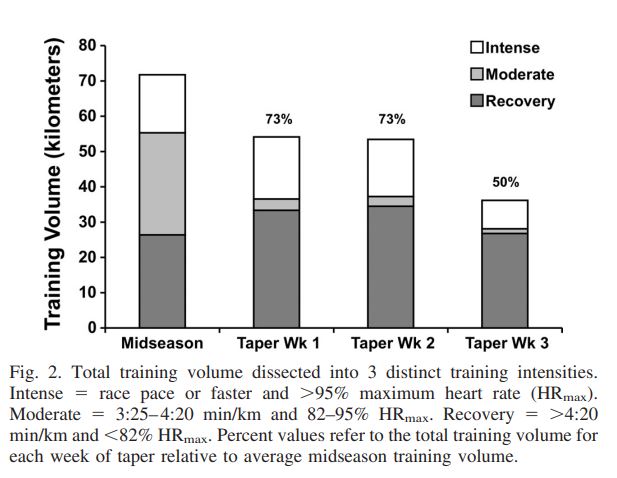Luden et al. published a study in the Journal of Applied Physiology in 2010 titled: “Myocellular basis for tapering in competitive distance runners.” studying the effects of tapering in Taylor University Cross Country runners. The purpose was to study the effects of a 3 week taper on the physiology of competitive distance runners. They studied 7 collegiate distance runners before and after a 3 week taper. These were the primary measures:
- 8-km cross-country race performance
- Gastrocnemius (calf muscle) single muscle fiber size and function (peak force, shortening velocity, and power)
- Baseline and exercise-induced gene expression 4 h after a standardized 8-km run
- Citrate synthase activity
- Maximal and submaximal cardiovascular physiology (oxygen consumption, ventilation, heart rate, and respiratory exchange ratio.)
How did tapering effect these measures?
- Race performance improved by 3% following taper.
- Myosin heavy chain IIa fiber (fast twitch fiber) diameter increased by 7%
- Peak force of the gastrocnemius improved 11% and absolute power increased 9%
- Taper induced a distinct post-exercise gene response – MuRF-1 was attenuated after taper and MRF4, HSP 72 and MT-2A had an exaggerated response.
- There were no changes in myosin heavy chain I (type 1 fiber, slow twitch) size or function.
- No changes in baseline gene expression
- No changes in citrate synthase activity
- No changes in cardiovascular function
Summary of the study

Luden et al. before and after a 3-week structured taper measured:
⦁ Single muscle fiber size
⦁ Contractile function
⦁ Baseline and exercise-induced gene expression
⦁ Citrate synthase activity
⦁ Maximal and submaximal cardiovascular physiology (including oxygen consumption, ventilation, HR, and respiratory exchange ratio)
from 7 competitive distance runners. From the taper, they found a 3% improvement in 8-km cross-country race performance. Their research found improved size and function of MHC IIa muscle fibers (type 2 – fast twitch), altered gene responses, and no change in MHC (type 1 – slow twitch) fiber size and function, baseline gene expression, citrate synthase activity, or maximal and submaximal cardiovascular function. This research suggests that muscle remodeling is an important component behind the improvements in peak running performance.
A 2-8% increase in performance from taper has been reported across different modes of activity (swimming, cycling, etc). This study found a 3% improvement in performance. An effective run taper includes a big reduction in training volume (more than 40% decrease from pretaper) over a 1 – 3 week period, without changing training intensity. Muscle power is force multiplied by velocity. This study examined muscle samples from each runner’s lateral gastrocnemius (outside calf muscle) before and after taper, finding an increased sensitivity of the MHC IIa (type 2- fast twitch) fibers to generating more power after taper.

The authors stress the importance of decreasing intensity for a proper taper. A study of collegiate runners showed no significant performance improvements following taper, likely due to the fact that they traded volume for intensity; meaning they substituted running volume with intensity (in the form of interval training). The whole point of the taper is to promote gains via rest and recovery. If performance equals positive training adaptation minus fatigue; then cutting fatigue with rest will yield better performance.
This study found a 15% increase in MHC IIa fiber cross-sectional area with the 3-wk taper. That’s a rate of about 5% a week. They also report that aerobic capacity (VO2 max) was maintained or improves with taper. The authors claim that the training done during taper is sufficient to prevent any decline in VO2max observed with detraining. Tapering has been shown to improve running economy (RE – less oxygen was needed to run at the same velocity). However, in this study, along with others cited by this paper; they found no change in running economy.
This study found no change in aerobic capacity for muscle metabolism (measured via citrate synthase – a crucial enzyme regulating mitochondrial function). The authors conclude that at a minimum, the data they collected support that aerobic function was at least maintained during the 3-week taper. The authors wrap up their research by claiming that the increase in MHC IIa single fiber power following taper probably contributed to the 3% improvement in running performance. This study provides strong evidence for distance runners to taper their training volume to prepare for peak performance.

Luden N, Hayes E, Galpin A, et al. Myocellular basis for tapering in competitive distance runners. J Appl Physiol (1985). 2010;108(6):1501-1509. doi:10.1152/japplphysiol.00045.2010
